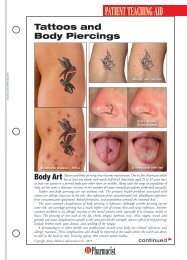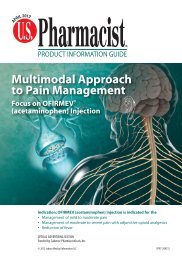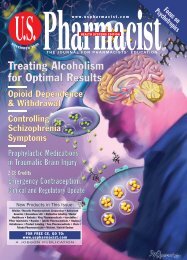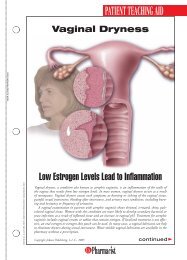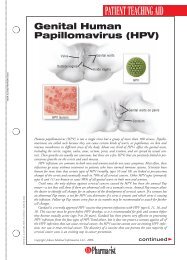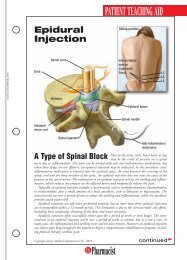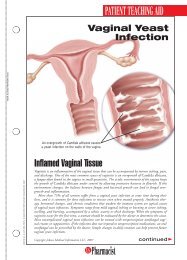Dry Eye - PharmQD
Dry Eye - PharmQD
Dry Eye - PharmQD
You also want an ePaper? Increase the reach of your titles
YUMPU automatically turns print PDFs into web optimized ePapers that Google loves.
PATIENT TEACHING AIDCauses Range FromAging to Certain Drugsto Environmental FactorsCorneaTEAR FILMOily layer(meibomianglands)Watery layer(lacrimalglands)<strong>Dry</strong> eye can be mild or severe, and symptoms can be occasionalor chronic. There are many causes of dry eye syndrome, includingsystemic diseases, drugs, and aging. The condition is morecommon in women, especially postmenopause. There are alsoseveral eye problems that can lead to dry eye syndrome,Mucus layer(epithelial cells)Tears are composed of three layers,each layer produced by different glands,so a problem with any of those sourcescan result in dry eye.including inflammation of the eyelids. People who live or work in dry environments or whostare for long periods of time without blinking are at higher risk for developing dry eye.Diagnosing <strong>Dry</strong> <strong>Eye</strong> SyndromeThe diagnosis of dry eye syndrome is made using a history of symptoms, visual inspection ofthe eye, and tests to determine if the amount of tears and their moisturizing ability are adequate.An optometrist can use simple office tests to make a rough estimate of the amount of tearsproduced, how well they cover the cornea, and the time it takes for tears to evaporate.Contact lenses may be a problem for people with dry eye syndrome. The type of lens orlength of wear time may need to be adjusted to increase eye moisture. Contact lenses may notbe an option to correct vision in some cases of chronic dry eye.Moisturizing <strong>Eye</strong>drops Relieve SymptomsTreatment for dry eye depends on the severity of the condition and its cause. If a cause canbe identified and treated, dry eye syndrome can often be improved. Inflammation of theeyelids may relieved by placing a warm washcloth over the eyes for a few minutes, then washingthe eyelids with a mild soap or special cleanser recommended by an eye care professional.In mild cases of dry eye, moisturizing eyedrops or eye ointments can give relief. Nonprescriptioneyedrops that simply lubricate the cornea are available with preservatives or in single-usepackets that are preservative free. These moisturizing eyedrops are best without preservativesif they are used more than four times a day. <strong>Eye</strong> ointments often blur vision, so they are bestused before bedtime. A twice-daily prescription eyedrop of cyclosporine can oftentimes relievedry eye due to inflammation of the cornea. Antibiotic or corticosteroid eyedrops may berequired for a short period if the eyelids are inflamed.In severe cases, when eyedrops or ointments are not sufficient to provide lubrication, a tinyeye gel insert can be placed inside the lower lid once a day. The insert slowly dissolves, lubricatingthe eye throughout the day. Punctal plugs as a temporary measure or a more permanentsurgical closure of the tear duct drainage holes is sometimes necessary to retain sufficient tearsin the eyes.Simple lifestyle changes can also help improve symptoms of dry eye syndrome. These includewearing wrap-around sunglasses in the wind, increasing the humidity levels at home, takingbreaks when staring at the computer, and avoiding drafts that blow directly on the face wheneverpossible.If you have questions about dry eye syndrome or the OTC or prescription eyedrops usedto treat this problem, ask your pharmacist. Your pharmacist can also show you how to properlyinsert eyedrops, gels, or ointments.




